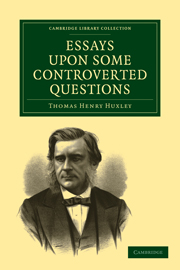Book contents
- Frontmatter
- Contents
- Dedication
- PROLOGUE
- I THE RISE AND PROGRESS OF PALÆONTOLOGY
- II THE INTERPRETERS OF GENESIS AND THE INTERPRETERS OF NATURE
- III MR GLADSTONE AND GENESIS
- IV THE EVOLUTION OF THEOLOGY: AN ANTHROPOLOGICAL STUDY
- V SCIENCE AND MORALS
- VI SCIENTIFIC AND PSEUDO-SCIENTIFIC REALISM
- VII SCIENCE AND PSEUDO-SCIENCE
- VIII AN EPISCOPAL TRILOGY
- IX AGNOSTICISM
- X THE VALUE OF WITNESS TO THE MIRACULOUS
- XI AGNOSTICISM: A REJOINDER
- XII AGNOSTICISM AND CHRISTIANITY
- XIII THE LIGHTS OF THE CHURCH AND THE LIGHT OF SCIENCE
- XIV THE KEEPERS OF THE HERD OF SWINE
- XV ILLUSTRATIONS OF MR. GLADSTONE'S CONTROVERSIAL METHODS
- XVI HASISADRA'S ADVENTURE
XIII - THE LIGHTS OF THE CHURCH AND THE LIGHT OF SCIENCE
Published online by Cambridge University Press: 29 August 2010
- Frontmatter
- Contents
- Dedication
- PROLOGUE
- I THE RISE AND PROGRESS OF PALÆONTOLOGY
- II THE INTERPRETERS OF GENESIS AND THE INTERPRETERS OF NATURE
- III MR GLADSTONE AND GENESIS
- IV THE EVOLUTION OF THEOLOGY: AN ANTHROPOLOGICAL STUDY
- V SCIENCE AND MORALS
- VI SCIENTIFIC AND PSEUDO-SCIENTIFIC REALISM
- VII SCIENCE AND PSEUDO-SCIENCE
- VIII AN EPISCOPAL TRILOGY
- IX AGNOSTICISM
- X THE VALUE OF WITNESS TO THE MIRACULOUS
- XI AGNOSTICISM: A REJOINDER
- XII AGNOSTICISM AND CHRISTIANITY
- XIII THE LIGHTS OF THE CHURCH AND THE LIGHT OF SCIENCE
- XIV THE KEEPERS OF THE HERD OF SWINE
- XV ILLUSTRATIONS OF MR. GLADSTONE'S CONTROVERSIAL METHODS
- XVI HASISADRA'S ADVENTURE
Summary
There are three ways of regarding any account of past occurrences, whether delivered to us orally or recorded in writing.
The narrative may be exactly true. That is to say, the words, taken in their natural sense, and interpreted according to the rules of grammar, may convey to the mind of the hearer, or of the reader, an idea precisely correspondent with one which would have remained in the mind of a witness. For example, the statement that King Charles the First was beheaded at Whitehall on the 30th day of January 1649, is as exactly true as any proposition in mathematics or physics; no one doubts that any person of sound faculties, properly placed, who was present at Whitehall throughout that day, and who used his eyes, would have seen the King's head cut off; and that there would have remained in his mind an idea of that occurrence which he would have put into words of the same value as those which we use to express it.
Or the narrative may be partly true and partly false. Thus, some histories of the time tell us what the King said, and what Bishop Juxon said; or report royalist conspiracies to effect a rescue; or detail the motives which induced the chiefs of the Commonwealth to resolve that the King should die. One account declares that the King knelt at a high block, another that he lay down with his neck on a mere plank. And there are contemporary pictorial representations of both these modes of procedure.
- Type
- Chapter
- Information
- Essays upon some Controverted Questions , pp. 501 - 534Publisher: Cambridge University PressPrint publication year: 2009First published in: 1892



